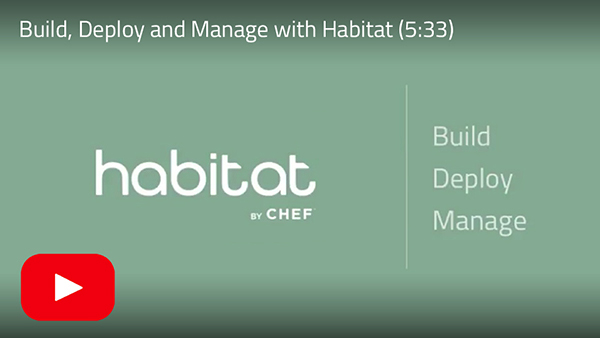Habitat is open source software that creates platform-independent build artifacts and provides built-in deployment and management capabilities.
The goal of Habitat is to allow you to automate your application behavior when you create your application, and then bundle your application with the automation it needs to behave with the correct run time behavior, update strategies, failure handling strategies, and scaling behavior, wherever you choose to deploy it.
See a quick demo of how to build, deploy and manage an application with Habitat:
Project State: Active
Issues Response Time Max: 5 business days
Pull Request Response Time Max: 5 business days
- Diagrams
- Training
- Install
- Contribute
- Documentation
- Code Organization
- Roadmap
- Community and support
- Building
- Native
- Further reference material
- Code of Conduct
- License
Graphics that will help you and your team better understand the concepts and how they fit together into the larger Habitat ecosystem.
Try the interactive infographics on the website!
- Architecture Overview
- Initial Package Build Flow
- Application Rebuild Flow
- Dependency Update Flow
- Promote Packages Through Channels
View all diagrams in Docs
View all demos and tutorials in Learn
You can download Habitat from the Habitat downloads page.
Once you have downloaded it, follow the instructions on the page for your specific operating system.
If you are running macOS and use Homebrew, you can use our official Homebrew tap.
$ brew tap habitat-sh/habitat
$ brew install hab
If you are running Windows and use Chocolatey, you can install our chocolatey package
C:\> choco install habitat
If you do not run Homebrew or Chocolatey, or if you use Linux, you can use the Habitat install.sh or install.ps1 script.
Bash:
$ curl https://raw.githubusercontent.com/habitat-sh/habitat/main/components/hab/install.sh | sudo bash
Powershell:
C:\> Set-ExecutionPolicy Bypass -Scope Process -Force
C:\> iex ((New-Object System.Net.WebClient).DownloadString('https://raw.githubusercontent.com/habitat-sh/habitat/main/components/hab/install.ps1'))
We are always looking for more opportunities for community involvement. Interested in contributing? Check out our CONTRIBUTING.md to get started!
Get started with the Habitat tutorials or plunge into the complete documentation.
The Habitat plans that are built and maintained by Habitat's Core Team are in their own repo.
The code for the Habitat Supervisor and other core components are in the components directory.
Habitat's website and documentation source is located in the www directory of the Habitat source code. See its README for more information.
The Habitat project's roadmap is public and is on our community page.
The Habitat core team's project tracker is also public and on Github.
- Chef Community Slack
- Forums
- The Chef Community meeting is every Thursday at 9am Pacific. More information can be found in the Connect section of Chef Community
See BUILDING.md for platform specific info on building Habitat from source.
See README.md for info on Native Packages.
- The Rust Programming Language
- Rust by Example
- Introduction to Bash programming
- Advanced Bash-Scripting Guide
- Bash Cheat Sheet
- Writing Robust Bash Shell Scripts
- Wikibook: Bourne Shell Scripting
- What is the difference between test, [ and [[ ?
- POSIX Shell Command Language
Participation in the Habitat community is governed by the code of conduct.
Copyright (c) 2016 Chef Software Inc. and/or applicable contributors
Licensed under the Apache License, Version 2.0 (the "License"); you may not use this file except in compliance with the License. You may obtain a copy of the License at
https://www.apache.org/licenses/LICENSE-2.0
Unless required by applicable law or agreed to in writing, software distributed under the License is distributed on an "AS IS" BASIS, WITHOUT WARRANTIES OR CONDITIONS OF ANY KIND, either express or implied. See the License for the specific language governing permissions and limitations under the License.

